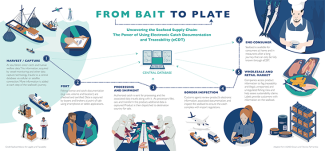The Seafood Alliance for Legality and Traceability (SALT) brings together the seafood industry, governments, and non-governmental organizations to collaborate and share seafood traceability knowledge and information on a global scale. Implemented by the sustainable seafood consultancy FishWise, SALT is a public-private partnership between USAID and the Packard, Moore, and Walton Family Foundations. From the many existing seafood traceability efforts around the globe, SALT grew a community that supports adopting “comprehensive” electronic catch documentation and traceability (eCDT) programs that address ecological, social, and economic goals in seafood.
To expand knowledge about the seafood supply chain, SALT produced the above infographic about how seafood moves “from bait to plate” and how eCDT can improve the safety and security of this process. This digital approach is more important than ever during the COVID-19 pandemic: eCDT allows for safer connections between people since they do not have to transfer paper products in person, and companies with better supply chain information are more resilient to the disruption of the pandemic.
The seafood supply chain begins with harvest/capture, where fishers at sea input digital information on their fishing activity, catches, and related human welfare standards. The next step is at the port, where fishing licenses and catch documentation (such as size, volume, and location) are checked and certified using digital apps. Following the port is processing and shipment, where approved catches are sent for processing. All of the data collected up to this point are sent with the product, and additional data are captured as the product is transformed for market. The next step is border inspection, at which point customs agents review all of the data associated with each catch, and inspect the seafood to ensure it complies with import regulations. After being reviewed and cleared, seafood goes to wholesale and retail markets, where companies access the product data to ensure compliance with their responsible sourcing policies and to assess sustainability. The final step in the seafood supply chain is the end consumer—the point at which seafood is available for consumers at home and in restaurants.
Ultimately, the power of eCDT is the efficient data collection that can help verify a seafood product’s origin and legality—increasing the transparency of supply chains. Progress toward implementing eCDT programs can help combat illegal, unreported, and unregulated catch from entering the supply chain. These data can also be helpful for fisheries management and minimizing risk of human rights and labor abuses in seafood supply chains. To support efforts in seafood traceability, SALT led the collaborative development of six Traceability Principles. These Principles are core ideas to keep in mind while designing or improving an electronic traceability program to better support and sustain ecological, social, and economic benefits. As SALT works with international stakeholders to apply these Principles to its traceability programs, more of the world will join forces to improve the transparency of seafood’s long journey from bait to plate.

